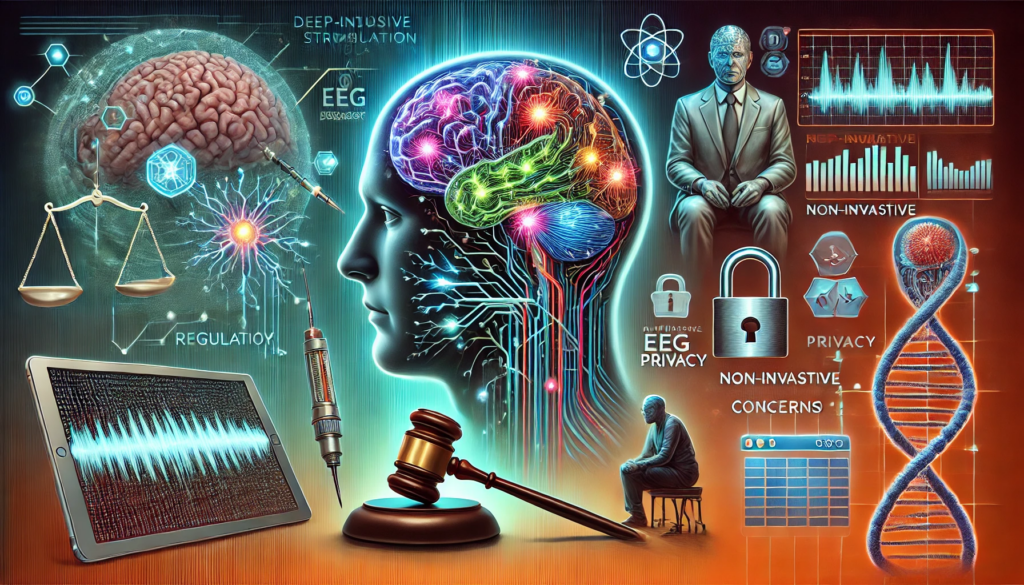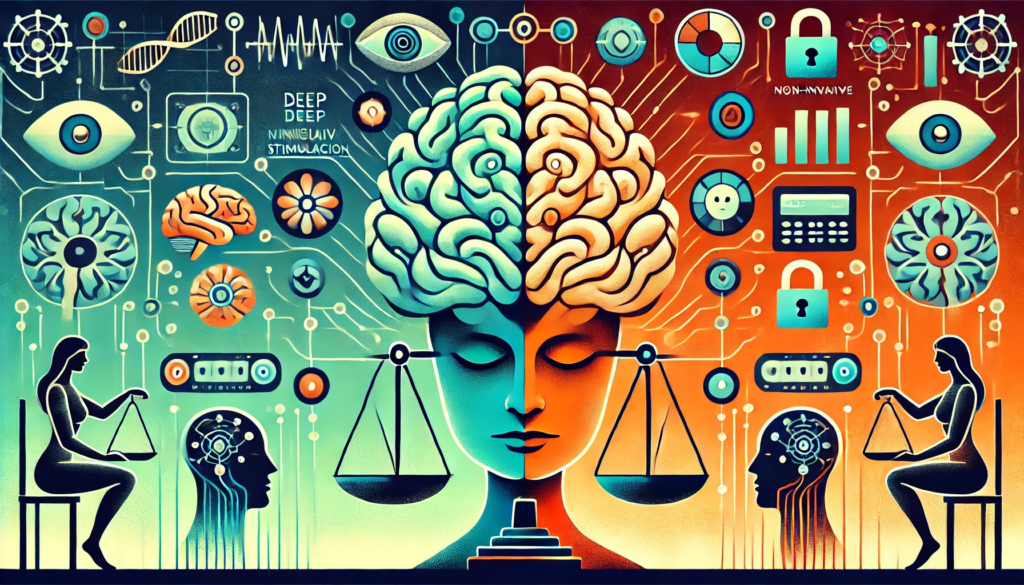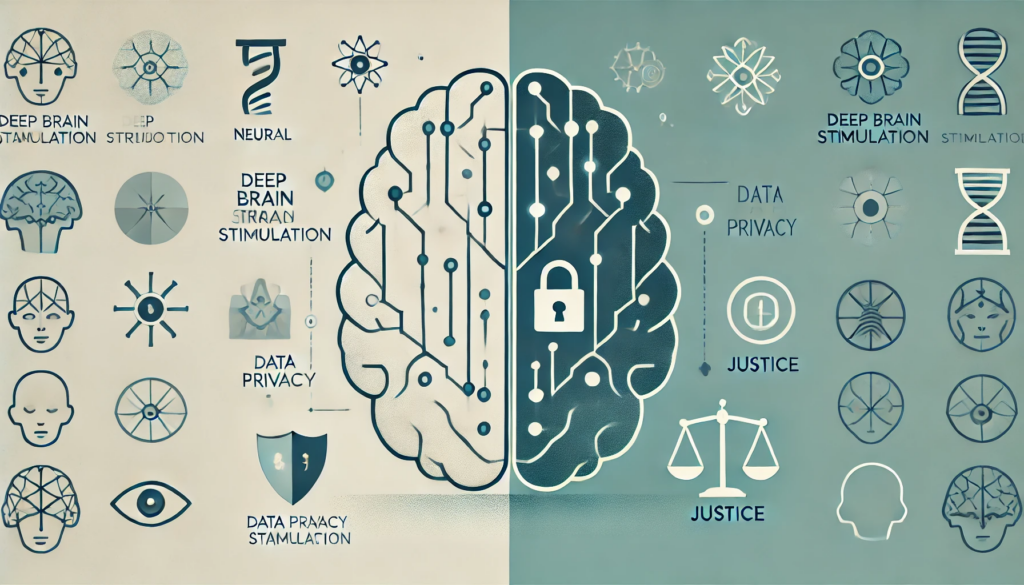
ChatGPT:
🧠 The Growing Accessibility of Neurotechnologies: Pros, Cons, and Future Challenges
Neurotechnologies, once confined to therapeutic and academic research, are increasingly entering consumer markets, offering tools to read and stimulate brain activity. While these advancements hold great promise, they also bring risks related to ethics, privacy, and accessibility. This detailed exploration covers their development, applications, commercialization, ethical challenges, and the need for regulation.
🔬 The Evolution of Neurotechnologies
🏥 From Therapy to Consumer Use
Initially focused on treating brain-related medical conditions like Parkinson’s disease, epilepsy, and depression, neurotechnologies now aim to enhance everyday cognitive abilities. Non-invasive devices, such as EEG headsets and stimulation tools, are sold for purposes like improving memory, sleep, or productivity.
💡 Key Milestones in Development
1. Therapeutic Breakthroughs:
• Deep Brain Stimulation (DBS): First performed in 1987 for Parkinson’s disease, DBS now treats depression, OCD, and epilepsy. Over 250,000 Parkinson’s patients have benefited.
• Transcranial Direct Current Stimulation (tDCS): Used for epilepsy and other conditions, tDCS applies mild electric currents to modulate brain activity non-invasively.
2. Consumer-Oriented Tools:
• Devices like Emotiv’s headsets measure brain activity for focus and stress tracking, marketed for workplace productivity and neuromarketing.
• Apple’s EEG-capable AirPods (patented but not yet released) aim to read brainwaves and biosignals.
🌐 Applications Across Sectors
🏥 Medical Advancements
• Therapeutic tools are addressing treatment-resistant neurological disorders, offering solutions where traditional medicine falls short.
• AI-driven algorithms enhance the interpretation of brain signals, enabling individualized treatments.
🏠 Consumer Benefits
• Devices designed for home use promise to improve sleep, boost memory, and enhance focus. For instance:
• Elemind’s Headband: Stimulates brain waves to deepen sleep cycles.
• BrainCo Headsets: Used in education and workplace settings to monitor attention and cognitive states.
🛑 Ethical and Privacy Concerns
🧩 Neural Data Protection
Neural data, often collected by consumer EEG devices, is increasingly recognized as sensitive information. However, only a few regions, like California and Colorado, have classified neural data as sensitive health data akin to biometrics.
Risks Include:
• Privacy Violations: Many neurotech companies reserve the right to share data with third parties, posing risks of misuse for surveillance or marketing.
• Manipulation: Data could be exploited for subliminal advertising or behavioral influence, as highlighted by physicist and philosopher Alexei Grinbaum.
💸 The Role of Private Funding
Private investors are propelling the development of neurotechnologies, often outpacing public funding.
• In 2023, brain-machine interface startups raised $429 million, two-thirds of the National Institutes of Health’s annual BRAIN Initiative budget.
• Key players include Elon Musk’s Neuralink, Bill Gates, and Jeff Bezos, who have backed innovative companies like Synchron.
This heavy reliance on private funding raises questions about motivations, accessibility, and oversight.
🌍 Global Disparities in Access
Despite advancements, neurotechnologies are far from universally accessible.
• Developed countries dominate innovation and usage, while developing nations face barriers due to high costs and infrastructure limitations.
• For example, while 500 Parkinson’s patients in France receive DBS annually, over 2,000 patients need it. In regions like Africa and India, usage is negligible.
Experts like Gabriel Lazaro-Munoz stress that without equitable access, these technologies risk becoming tools for the wealthy, exacerbating global inequalities.
🚨 Calls for Regulation
🛡️ Governance Efforts
• UNESCO is working to create global guidelines for neurotechnology ethics and governance, with recommendations expected by 2025.
• In Europe, the upcoming AI Act (effective 2025) restricts using neurotechnology to assess emotions in educational or workplace contexts.
📜 International Ethical Standards
Ethicists and researchers emphasize the need to protect vulnerable patients and ensure neurotechnologies serve therapeutic purposes, not commercial exploitation.
🤖 Future Directions and Challenges
⚙️ Scientific Challenges
• AI algorithms that interpret neural data still face limitations in accuracy and reliability, especially for non-invasive tools.
• Researchers caution against over-promising capabilities, as the science behind neurotechnologies is still evolving.
🎯 Ethical Use
• There’s a growing debate about using these tools to augment healthy brain functions (e.g., enhancing memory) rather than strictly therapeutic applications.
• Experts like Ismail Kola advocate for neurotechnologies to restore normality, not create “superhuman” capabilities.
📝 Conclusion
The rise of neurotechnologies offers immense potential to transform medicine and everyday life. From treating complex neurological disorders to improving cognitive functions, these innovations promise significant benefits. However, their commercialization introduces risks of misuse, privacy violations, and unequal access. Strong governance, ethical oversight, and international collaboration are crucial to ensuring these technologies serve humanity responsibly and equitably.

Scientific Challenges and Possible Negative Consequences of Neurotechnologies
As neurotechnologies expand from therapeutic research into consumer markets, they face numerous scientific and technical challenges, alongside potential negative consequences. These range from limitations in understanding brain activity to ethical risks and unforeseen societal impacts.
🧠 Scientific Challenges
1. Complexity of the Brain
The human brain is vastly intricate, with billions of neurons interacting in complex patterns. While neurotechnologies aim to decode and influence these patterns, the science is still in its infancy.
• Signal Interpretation: Current AI models and algorithms often struggle to accurately decode neural signals. Transcranial signals, for instance, are difficult to analyze due to noise and lack of specificity.
• Individual Variability: Brain structure and function vary significantly between individuals, making it challenging to create universal tools or therapies.
2. Lack of Long-Term Studies
Many neurotechnologies are being deployed without robust, long-term studies to assess their safety and efficacy.
• For example, while deep brain stimulation (DBS) has shown success in treating Parkinson’s disease and depression, its effects on cognitive and emotional functions over decades remain unclear.
• Shortcomings in trials can lead to unexpected side effects, especially when devices fail or are removed prematurely.
3. Accuracy of AI Models
AI plays a critical role in analyzing brain data, but it is far from perfect:
• Overfitting: Algorithms trained on limited datasets may produce inaccurate predictions when applied to diverse populations.
• Bias: Neural data from underrepresented groups may skew results, limiting effectiveness for minority demographics.
4. Therapeutic vs. Enhancement Uses
Many neurotechnologies lack clear boundaries between therapeutic and enhancement applications.
• Tools initially designed for medical treatment, like EEG headbands, are now being marketed for improving memory, focus, or sleep. This raises scientific questions about their effectiveness and safety for non-clinical uses.
🔴 Possible Negative Consequences
1. Health Risks and Device Malfunctions
• Invasive Procedures: Devices like implants carry risks of infection, bleeding, and nerve damage. Removing or replacing implants can lead to further complications.
• Unintended Side Effects: Electrical stimulation may inadvertently affect unintended brain regions, causing mood changes, cognitive impairments, or new symptoms.
• Device Failures: Patients have reported severe consequences when companies abandon trials or fail to maintain devices after market withdrawal.
2. Privacy Violations and Data Misuse
Neural data, which reflects a person’s thoughts, emotions, and cognitive tendencies, is highly sensitive. Without adequate protection, this data could be exploited.
• Commercial Exploitation: Companies might sell neural data for marketing purposes, predicting behaviors, or even influencing decisions without user consent.
• Surveillance Risks: Governments or corporations could use neurotechnologies for intrusive monitoring or behavior modification.
3. Mental and Emotional Impacts
• Dependence on Devices: Over-reliance on neurotechnologies for cognitive or emotional regulation could create dependency, reducing natural resilience.
• Negative Self-Perception: Consumers using enhancement tools might feel inadequate without them, perpetuating cycles of low self-esteem.
4. Ethical Concerns About Manipulation
• Subliminal Influence: Neural data could be used to subtly manipulate emotions, choices, or actions, creating ethical dilemmas around free will.
• Targeting Vulnerable Groups: Devices marketed as “miracles” might exploit desperate individuals, such as those suffering from mental illness or neurodegenerative conditions.
5. Inequities in Access
Neurotechnologies are expensive and technologically complex, creating a divide between those who can afford them and those who cannot.
• Healthcare Gaps: Patients in low-income regions may lack access to life-changing therapies like DBS or tDCS.
• Augmented Inequality: Wealthier individuals might use neurotechnologies for enhancement, widening societal inequalities further.
6. Unintended Societal Impacts
• Workplace Implications: Neurotechnologies marketed for improving focus or monitoring productivity could be misused by employers to exert undue control over workers.
• Educational Challenges: Tools for enhancing attention in students might create unfair advantages for those who can afford them, deepening disparities in academic outcomes.
7. Resistance to Oversight
Efforts to regulate neurotechnologies face resistance from powerful companies, especially in jurisdictions with weak privacy laws.
• Weak Protections: As noted, 29 out of 30 companies offering EEG-based products do not restrict access to user data, making it vulnerable to misuse.
• Slow Governance: While some governments like California have started enacting laws, global regulation remains fragmented, leaving gaps that corporations can exploit.
📝 Conclusion
While neurotechnologies hold promise for advancing human health and cognitive capabilities, they face significant scientific and ethical challenges. The complexity of brain activity, reliance on unproven AI models, and limited long-term studies raise questions about safety and efficacy. Potential negative consequences, including health risks, privacy violations, and societal inequities, demand urgent attention. To ensure responsible development, robust scientific validation, clear ethical guidelines, and equitable global access must accompany technological advancements. Without such measures, these tools risk doing more harm than good.
FAQs on Neurotechnologies
1. What are neurotechnologies?
Neurotechnologies are tools and devices designed to analyze or influence brain activity. They range from invasive methods, like brain implants, to non-invasive tools, such as EEG headbands, and are used for therapeutic purposes or cognitive enhancement.
2. What are the main therapeutic applications of neurotechnologies?
Neurotechnologies are used to treat various neurological and psychiatric conditions, including:
• Parkinson’s disease (via Deep Brain Stimulation).
• Epilepsy (via transcranial direct current stimulation).
• Depression, OCD, Tourette’s syndrome, and essential tremor syndrome.
These technologies are often employed when traditional treatments fail.
3. How do consumer neurotechnologies differ from therapeutic ones?
Consumer neurotechnologies are marketed for general use, such as improving sleep, boosting memory, or increasing focus. They include headsets and headphones that measure brain activity for stress or concentration monitoring. Therapeutic tools, on the other hand, are specifically designed to treat medical conditions.
4. What are the ethical concerns surrounding neurotechnologies?
Key ethical issues include:
• Privacy: Misuse of neural data for marketing, surveillance, or manipulation.
• Free Will: Risks of influencing emotions, thoughts, or decisions.
• Exploitation: Targeting vulnerable patients or populations without adequate safeguards.
5. Are neurotechnologies safe?
Safety varies by device. Invasive tools like brain implants carry risks of infection, nerve damage, and unintended side effects. Non-invasive devices are generally safer but lack robust, long-term studies to confirm their efficacy and risks.
6. What is being done to protect neural data?
Some regions, like California and Colorado, classify neural data as sensitive health information, granting it protections similar to biometric data. However, global regulations remain inconsistent, with many companies still reserving the right to sell or transfer user data.
7. Who funds neurotechnology development?
Neurotechnologies receive funding from both public institutions and private investors. In 2023, startups in this field raised $429 million, with key backers including Elon Musk (Neuralink), Bill Gates, and Jeff Bezos. Private investment often outpaces public funding, raising concerns about commercialization.
8. What are the possible risks of using consumer neurotechnologies?
• Over-reliance: Users may become dependent on devices for cognitive or emotional regulation.
• Health Risks: Misuse of non-validated tools can lead to unintended effects.
• Data Exploitation: Sensitive neural data may be used without proper consent.
9. Why are neurotechnologies criticized for accessibility issues?
High costs and technical complexity limit access to these tools, particularly in developing regions. For instance, while many in developed countries benefit from deep brain stimulation, only a fraction of eligible patients in low-income regions receive such treatments.
10. What is being done to regulate neurotechnologies?
Governments and organizations like UNESCO are working on guidelines for ethical neurotechnology use. For instance:
• UNESCO: Recommending global regulations by 2025.
• EU AI Act: Restricting certain uses of AI-driven neurotechnologies in workplaces and education.
• US Laws: States like California and Colorado are leading efforts to classify neural data as sensitive health data.

